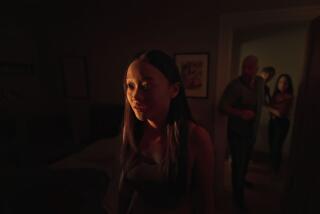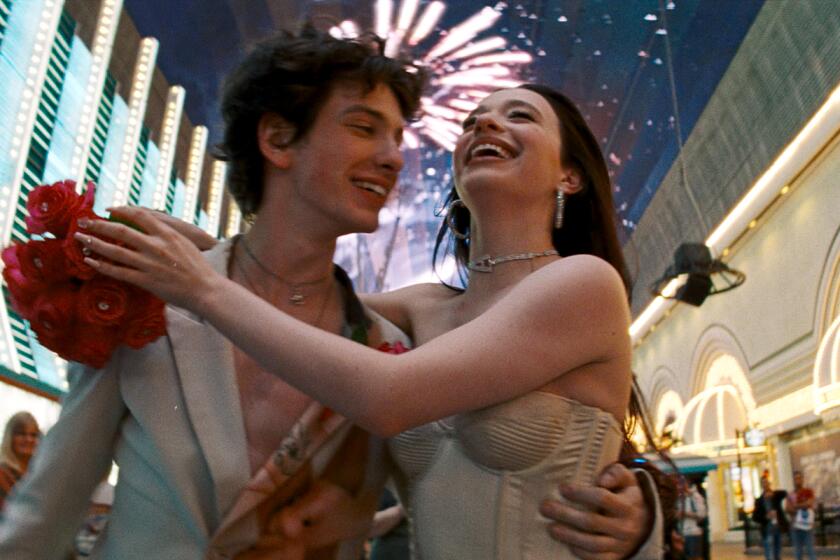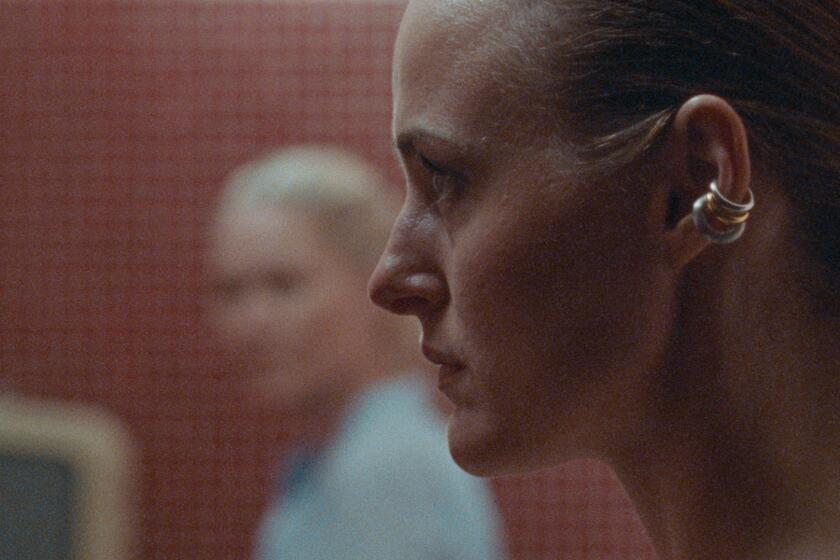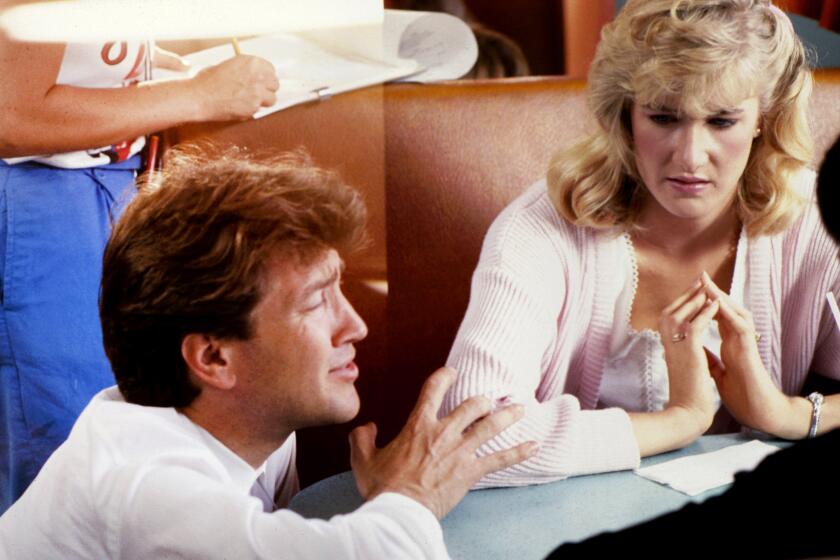A look inside Hollywood and the movies. : FILM COMMENT : Where Has the Thrill Gone? : There’s nothing baffling about the modern Hollywood mystery
- Share via
Two friends exit a screening of “Basic Instinct” and pass a group of protesters with signs proclaiming “Catherine Did It.” One friend turns to the other and says: “How can they be so sure?”
This joke--which was replayed for real for months after “Basic Instinct” opened--is central to the current Hollywood mystery-thriller scene. It’s not uncommon now for audiences to leave a whodunit still wondering whodunit--not to mention howdidit. We walk into movies like “Basic Instinct” and “White Sands” and “Final Analysis” and “A Stranger Among Us” and “Whispers in the Dark” and “Unlawful Entry” and “Single White Female” hoping to be shocked and baffled before the inevitable enlightenment and instead we exit more blinkered than when we walked in. Even when it’s possible to dope out the clues, the connections are often so arbitrary that we seem to be putting more effort into figuring things out than the filmmakers.
At issue is nothing so royal as “deliberate” ambiguity. Forget “Kafkaesque.” What’s really going on here is just plain old bumbling storytelling. Has Hollywood lost the knack for making mystery-thrillers?
Of course, these days mystery-thrillers aren’t the only movies to provoke an outbreak of head-scratching. One would not readily mention a film like “Housesitter” in the same breath with the word “plausible.” (Or “good.”) But mysteries, at least the conventional sort that Hollywood specializes in, are supposed to make storytelling sense. The degeneration of the mystery-thriller--including those films that shade into psychological and horrific terrain--has to be seen as part of a much larger problem: the degeneration of movie storytelling in a short-attention-span, anything-for-effect era. The problem is glaringly obvious in the thriller arena only because the well-worked-out plot is the mystery thriller’s stock-in-trade.
An added problem here is that audiences may not care that much anymore whether the pieces fit together or not. “Sleeping With the Enemy,” for example, was a smash hit despite a plot with Titanic-sized leaks. (Why would an abused wife who meticulously faked her own death in a boating accident immediately return to her husband’s lair to pack before disappearing? Why wouldn’t this most suspicious of men wonder why her body never washed up on shore?) Movie mysteries have rarely been air-tight--even Hitchcock had his lulus--but until fairly recently the assumption was that at least they were supposed to be.
The mystery-thriller, like virtually every other Hollywood production, exists today in order to deliver the mass-marketable goods. And that means they have to pass the usual battery of test-market criteria. What counts are stars, no matter how inappropriately cast; action, no matter how inappropriately inserted. What we get in the new mystery-thriller are thrills without logic, without context. The paradox of the current situation is that mysteries are predicated on surprise and yet the Hollywood product is predicated on predictability--on the elimination of surprise.
Audiences are treated to a wearying repetition of whatever is currently testing well in the research polls. This partially explains why we are now being inundated with Obsessive Maniac From Hell movies. The thudding predictability of these films cries out for parody. If only the Zucker brothers and Jim Abrahams would regroup to kill off the genre, “Airplane!”-style. How about a mystery-thriller where the maniacs, all of whom have miraculously survived their previous outings, find themselves in the same movie? Jennifer Jason Leigh (“Single White Female”), on the run from Robert De Niro (“Cape Fear”), could room with Michael Keaton (“Pacific Heights”), who then has an affair with Glenn Close (“Fatal Attraction”), who in turn gets dumped in favor of Rebecca De Mornay (“The Hand That Rocks the Cradle”), whereupon they all get busted by Ray Liotta (“Unlawful Entry”) and eaten by Anthony Hopkins (“The Silence of the Lambs”).
The Obessive Maniac movie fits the direct-action requirements of undemanding audiences. (And young audiences in particular without a sense of film history may not be hip to the cliches of the genre.) Characterization is ultimately focused into a single pinpoint of mania; all emotional and cultural shadings are jettisoned in favor of the overwhelming working out of an obsession. It’s a mechanistic formula that suits a mechanistic, assembly-line approach to filmmaking--and to human experience.
This clanking mechanization is at odds with the insights of psychology. Perhaps this is why the Obsessive Maniac From Hell movie often overlaps the Psychiatrist From Hell movie, as in the case of “Whispers in the Dark” and “The Silence of the Lambs.” Add to this list “Final Analysis,” “Dead Again” and “Raising Cain” and you’re faced with an inescapable conclusion: There’s a whole lotta shrink-bashing going on.
Psychiatrists are often featured in mystery-thrillers as detectives of a sort--detectives of the mind. Their clinical rationality is supposed to function as the fixed compass in a magnetic storm of mayhem. But although the psychiatrists are still cast in the traditional heroic “detective” role--such as Annabella Sciorra in “Whispers in the Dark” and Richard Gere in “Final Analysis”--they are so thick-witted that the point seems to be that psychiatrists are the first to be fooled and the last to know. Their analytic skills don’t connect up to this straitened world.
The shrink-bashing points up how starved we are for villains; political sensitivities have rendered just about everybody else off-limits. But women are still fair game. For most of the past decade, actresses have had an insubstantial stake in the increasingly action-oriented Hollywood product line. Now Hollywood has found a way to retro-fit women into the machinery. They’ve become predatory harridans; their weapons of choice include spiked heels and ice-picks. These terrorists are simply the flip side of the dewy, maidenly types, like Julia Roberts, who find themselves terrorized. The sexuality of a Sharon Stone or a Rebecca De Mornay or a Kim Basinger is slicked up into a lethal weapon.
One reason why many of these mystery-thrillers are so confusing and convictionless is that the directors aren’t really committed to them; they make them because these are the films that are getting financed now. Barbet Schroeder, whose last film was the elegantly sly “Reversal of Fortune,” is the exact wrong director for “Single White Female.” (That title, by the way, is a misnomer, and typical of how the new thrillers dispense logic for effect; it sounds like a spicy personal ad, not an ad for a roommate.) In “Stranger Among Us,” Sidney Lumet seems much more at home with the Hasidic material, romanticized as it is, than he does with the murders, which keep ramming the fairy-tale mood.
It’s not plot but character that really carries us through the best mystery-thrillers. (Consider, most recently, the dreary “Whispers in the Dark,” where all the pieces finally interlock yet all the characters are twigs.) Hitchcock understood this better than anyone else. It’s not the set pieces and the bits of business that are truly memorable in his films; it’s the set pieces and bits of business as filtered through characters like Jimmy Stewart’s Scotty in “Vertigo,” or Anthony Perkins’ Norman Bates in “Psycho.” The famous crop-duster scene in “North by Northwest” works because that’s Cary Grant being buzzed in those cornfields.
How many memorable characters have there been in the new batch of thrillers? Even the harridan headliners, like Stone in “Basic Instinct” or DeMornay in “The Hand That Rocks the Cradle,” are rousers primarily because they play out a single, take-no-prisoners fixation. They’re not characters, really. They’re wind-up toys.
It’s possible that the armature of the traditional mystery--the clear-cut sense of right and wrong, of paying for our crimes, of trusting our lawmakers--has been shattered for our generation. We may not so readily accept anymore the neat resolutions of chaos that these films often provide. The mystery-thriller, starting with Edgar Allan Poe, developed alongside an almost religious faith in the power of science and technology to re-order our lives for the good. But technology has not shielded our lives from terror. The random murders we read about and see on television seem motiveless and conscienceless--they eclipse and trivialize their fictional counterparts.
These zig-zags in the Zeitgeist work against formula filmmaking but they challenge filmmakers like David Lynch and Brian De Palma, who together in the past decade have extended the range of the mystery-thriller. With “Blue Velvet” and the TV series “Twin Peaks,” Lynch created a ghastly new mood for the mystery-thriller that seemed to blend the Hardy Boys, Krafft-Ebbing and L.L. Bean. He starts from a state of small-town normalcy only to unveil an entire zoology of freakdom. In Lynch’s peachy-keen universe, everyone is malignant, and the kick of a murder-mystery like “Twin Peaks” is that it has no real solution, only a series of possible solutions.
De Palma begins with the idea that the world is already depraved. His thrillers start out freaky and get freakier. And, as with Lynch, all the dirty little secrets turn out to be sexual. De Palma’s best scare films, “Carrie,” “Dressed to Kill” and “Blow Out,” brought right out into the open the mock-sadistic relationship that exists between a thriller filmmaker and his audience; he prolonged his horrors and tricked up his gambits in ways that made it clear he was toying with the very techniques that scare us. His thrillers are italicized with “knowingness.” The frights are impossibly dreamlike and hyperbolic--aestheticized worst-possible-case scenarios. And yet his films still make you jump. Underneath De Palma’s goofball grotesquerie is a deadly serious grotesquerie. The Catholic imagery in his movies, such as Piper Laurie being pinioned like St. Sebastian in “Carrie,” or Lolita Davidovich stowing her lover’s present in a motel room drawer next to the Gideon Bible in his new film “Raising Cain,” attests to a ripe sense of sin--perhaps a prerequisite for a great mystery-thriller filmmaker. (Hitchcock had it too.) “Raising Cain,” while it certainly doesn’t add anything new to what De Palma has done in the past, wasn’t nearly as bad as many of the reviews indicated. At its best, it has what Lynch’s finest films also have: a scariness so compelling that the filmmaker’s own panting fear comes through.
It’s often said that people go to mystery-thrillers to exorcise their fears. In the best ones, the exorcism belongs to the filmmakers too. We understand in our bones why they had to rid themselves of their incubus and solve the mystery. What’s missing from most of the new thrillers is precisely this sense of communicable dread. Without it, we in the audience might as well be doing crossword puzzles in the dark.
More to Read
Only good movies
Get the Indie Focus newsletter, Mark Olsen's weekly guide to the world of cinema.
You may occasionally receive promotional content from the Los Angeles Times.










